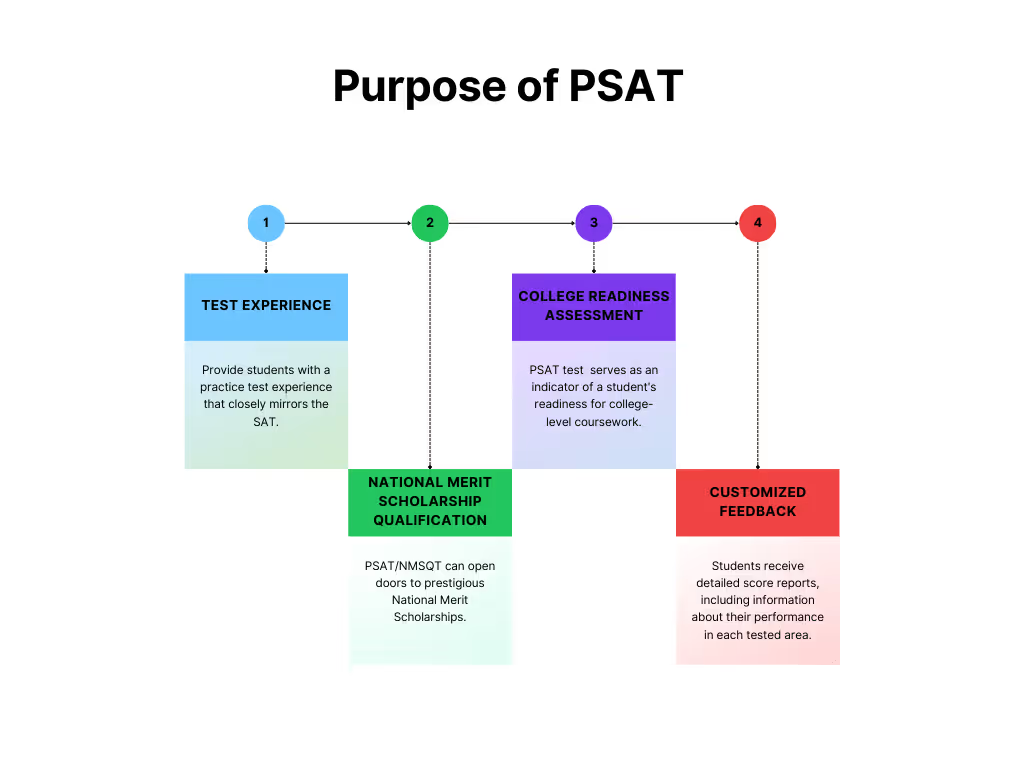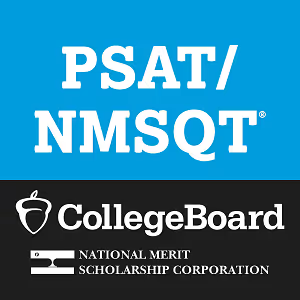

.avif)


Key Takeaways
- PSAT Digital Format for College Readiness: Discover how the PSAT’s digital format prepares you for the SAT and provides detailed feedback to improve your academic performance
- Unlock Scholarships with PSAT/NMSQT: Learn how excelling in the PSAT/NMSQT can lead to National Merit Scholarships and boost your college admissions prospects
- Adaptive Testing for Personalized PSAT Experience: Explore how the digital PSAT adapts to your skill level, offering a tailored and secure testing experience
Introduction
Standardized tests like ACT, SAT, PSATs, and LSATs have emerged as key tools in offering a standardized, objective, and widely recognized way to assess students' academic abilities and potential for unbiased admissions.
The SAT Suite of Assessments includes the SAT, PSAT/NMSQT, PSAT 10, and PSAT 8/9. These College Board tests assess consistent skills and knowledge, adjusted for the respective grade levels of participants. Both the SAT and PSATs have adopted digital formats. While the digital SAT is currently available internationally, it will be introduced in the USA in March 2024. However, the digital PSAT will be administered to all from October 2023.
The PSAT is more than just a practice test. It offers students an opportunity to experience the format and structure of the SAT firsthand. By taking the PSAT, students gain familiarity with the types of questions, timing, and content they will encounter in the SAT, thereby reducing anxiety and uncertainty surrounding this pivotal exam. With PSAT going digital and the first digital assessment (for PSAT/NMSQT and PSAT 8/9) scheduled between October 2nd - October 31st, 2023 we need to delve into what the PSAT is, explore its different types, and shed light on why it is making a transition as the digital PSAT.

What is the PSAT?
“PSAT” stands for “Preliminary SAT” but has no meaning on its own as there is no single test, but rather three PSAT-related assessments: the PSAT 8/9, PSAT 10, and PSAT/NMSQT (Preliminary SAT/National Merit Scholarship Qualifying Test). All assessments in the suite test reading, writing and language, and math skills. Typically, testing starts with the 8th and 9th graders taking the PSAT 8/9. Then in 10th grade students take the PSAT 10 or PSAT/NMSQT. Once in the 11th grade, students can take the PSAT/NMSQT, the SAT or both.
Purpose of the PSATs

1. Practice Test Experience
One of the primary purposes of the PSAT test is to provide students with a practice test experience that closely mirrors the SAT. The SAT is a standardized test widely used by colleges and universities in the United States as part of their admissions process. Therefore, the PSAT serves as a valuable opportunity for students to become familiar with the format, content, and structure of the SAT.
2. National Merit Scholarship Qualification
The PSAT/NMSQT (National Merit Scholarship Qualifying Test) is specifically taken by high school juniors. Scoring well on this version of the PSAT can open doors to prestigious National Merit Scholarships. High scorers in this test are eligible for various scholarship opportunities, which can significantly ease the financial burden of college education.
3. College Readiness Assessment
Beyond its role as a practice test, the PSAT test also serves as an indicator of a student's readiness for college-level coursework. The test assesses critical reading, mathematics, and writing skills, providing valuable insights into a student's academic strengths and areas for improvement.
4. Customized Feedback
Upon completing the PSAT test, students receive detailed score reports, including information about their performance in each tested area. This feedback helps students and educators identify areas where additional preparation is needed
Types of PSAT
Over the years, the PSAT test has evolved, leading to the creation of different types to cater to various student needs. Here are the main types of PSAT exams:
1. PSAT/NMSQT (National Merit Scholarship Qualifying Test)

Audience: High school juniors (11th graders)
Purpose: The PSAT/NMSQT is primarily known as the National Merit Scholarship Qualifying Test. It serves as a critical step for students interested in earning National Merit Scholarships. Scoring well on this test can lead to significant recognition and scholarship opportunities. The digital PSAT/NMSQT offers you a chance to get familiar with the digital SAT and to practice taking the test. Additionally, the PSAT/NMSQT can help you gauge your readiness for the SAT, so you know which areas you need to focus on in order to improve your score. Your PSAT/NMSQT score report will show you a breakdown of the kinds of questions you missed, which is useful for directing your SAT prep.
Content: The PSAT/NMSQT closely mirrors the SAT, consisting of sections in Reading and Writing and Mathematics.
PSAT/NMSQT Scoring Scale: The total score is the sum of two sections (Reading & Writing Section + Math Section). The score ranges from 320-1520. Each section score ranges from 160-760.

Benefits:
- National Merit Scholarship Eligibility: High-performing students on the PSAT/NMSQT have the chance to qualify as National Merit Semifinalists, which can lead to scholarships from colleges and universities.
- College Readiness: The test provides valuable insights into a student's preparedness for college-level coursework.
- SAT Preparation: It offers a preview of the SAT, helping students become more familiar with the format and content of the college admissions test they will take in the future.
2. PSAT 10

Audience: High school sophomores (10th graders)
Purpose: The PSAT 10 serves as a practice test for students one year before they take the PSAT/NMSQT in their junior year. It is designed to help students gauge their readiness for the more crucial PSAT/NMSQT and the subsequent SAT.
Content: The PSAT 10 shares similarities with the PSAT/NMSQT, featuring sections in Reading, Writing and Language and Mathematics.
PSAT 10 Scoring Scale: The total score is the sum of three sections (Reading Section + Writing & Language Section + Math Section). The score ranges from 320-1520. Each section score ranges from 160-760.

Benefits:
- Early Preparation: Taking the PSAT 10 allows students to identify their strengths and weaknesses, helping them focus their efforts on areas that need improvement before the critical junior-year PSAT.
- College Readiness Assessment: It provides an early indicator of a student's college readiness, helping them set academic goals and plan for their future.
3. PSAT 8/9

Audience: Eighth and ninth graders
Purpose: The PSAT 8/9 is specifically designed for younger students (eighth and ninth grades), typically in the 8th and 9th grades. It aims to provide an early assessment of their academic skills, college and career readiness, and areas where improvement may be needed.
Content: This test assesses knowledge in Reading and Writing and Mathematics, helping students develop foundational skills in these areas.
PSAT 8/9 Scoring Scale: The total score is the sum of two sections (Reading & Writing Section + Math Section). The score ranges from 240-1440. Each section score ranges from 120-720.

Benefits:
- Early Skill Development: The PSAT 8/9 is an early opportunity for students to gauge their academic strengths and areas for improvement, setting a foundation for their high school education.
- Academic Planning: Results can guide students in choosing appropriate coursework and extracurricular activities to align with their future goals.
- College and Career Readiness: It helps students understand the academic skills required for success in college and future careers.
The PSAT Digital Transition
The transition of the PSAT to a digital format is a testament to the changing landscape of education and assessment. Here's why this shift is significant:
1. Accessibility and Convenience
Going Digital: The shift to a digital format makes the PSAT more accessible to a wider range of students. And, also allows for greater flexibility in scheduling and administration.
2. Score Reporting
Insightful Feedback: Digital PSAT exams enable insightful test scores reporting. This feedback is invaluable for students as it empowers students with insights into their performance, identifying areas of strength and weaknesses in real-time.
Informed Preparation: Armed with detailed score reports, students can make informed decisions about their test preparation. They can identify specific areas that require more attention and focus their study efforts accordingly. This personalized feedback enhances the effectiveness of their test preparation.
(Note: As of now the expected results of the PSAT test should be declared within 4-6 weeks.)
3. Multi Stage Adaptive Testing (MST)
Like Digital SAT, PSAT is also section adaptive, a dynamic approach where the difficulty of sections/ modules adapts based on a student's response. The baseline module is of moderate difficulty and if a student performs well in the first module, the subsequent module may become more challenging. Conversely, if a student struggles with the first module, the test may adjust to a slightly lower difficulty level.
4. Security Enhancements
Advanced Security Measures: Digital testing can incorporate advanced security measures to maintain the integrity of the test. These may include features such as secure browser settings, biometric authentication, and real-time monitoring to detect and prevent cheating attempts.
Data Security: Digital testing also allows for secure storage and transmission of test data, minimizing the risk of data breaches or tampering. This enhances the overall security of the testing process.
How to Calculate Digital PSAT Score
The digital PSAT scoring system provides a detailed breakdown to help students understand their performance in both Reading & Writing and Math. Each section is scored separately, ranging from 160 to 760 points, making the total possible score between 320 and 1520.
To calculate your digital PSAT score, each section’s score is derived based on the number of correct answers. The test also adapts to a multi-stage adaptive testing (MST) format, meaning the difficulty of questions adjusts based on how well you perform in each section. If you answer questions correctly in the initial module, the next set of questions may be more challenging; if not, the test adapts to a slightly lower difficulty level. This adaptive approach helps to accurately measure your abilities and tailor the score to reflect your performance.
Once the digital PSAT is completed, students can expect to receive their scores online within 4-6 weeks. The digital score report provides insights into strengths and areas for improvement, which can be invaluable for refining preparation strategies for future standardized tests. By reviewing your digital PSAT score report, you can make informed adjustments to your study plan, focusing on areas where you can further enhance your skills.
Conclusion
In summary, the PSAT is a vital standardized test in the United States educational system. It serves multiple purposes, including providing students with practice for the SAT, identifying National Merit Scholarship candidates, assessing college readiness, and offering personalized feedback for academic improvement. The PSAT plays a crucial role in helping students prepare for the challenges of college admissions and academic success.
(Note: PSAT is a trademark registered by College Board, which is not affiliated with, and does not endorse this site.)

Tutors Edge by EdisonOS
in our newsletter, curated to help tutors stay ahead!
Tutors Edge by EdisonOS
Get Exclusive test insights and updates in our newsletter, curated to help tutors stay ahead!
Recommended Reads
Recommended Podcasts






.png)




.png)
.webp)
